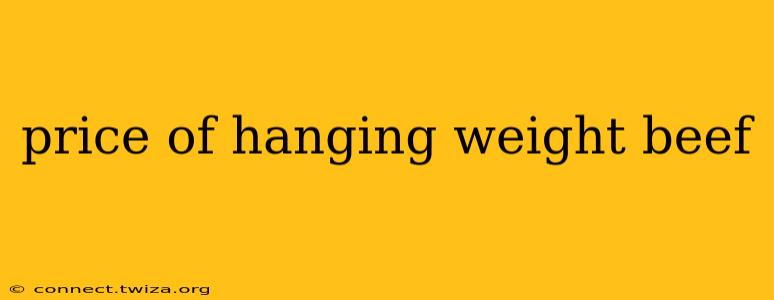The price of hanging weight beef can vary significantly depending on several factors. Understanding these factors will empower you to make informed decisions when purchasing beef directly from a butcher or farmer. This guide breaks down the cost, influencing variables, and helps you determine the best value for your money.
What is Hanging Weight?
Before diving into pricing, let's clarify what "hanging weight" means. Hanging weight refers to the weight of the carcass before it's butchered and processed. This weight includes the head, hide, and internal organs, all of which are removed later. The final, consumer-ready cuts will weigh considerably less. This is a crucial distinction because the price is typically quoted per pound of hanging weight.
Factors Affecting the Price of Hanging Weight Beef
Several key factors influence the price you'll pay for hanging weight beef:
1. Breed of Cattle:
Different breeds have varying characteristics affecting meat quality and price. For example, Wagyu beef, known for its intense marbling and tenderness, commands a significantly higher price than standard breeds like Angus or Hereford. The breed directly impacts the final product's quality and, consequently, the cost.
2. Grade of Beef:
The USDA grading system categorizes beef based on factors like marbling, maturity, and firmness. Prime grade beef, with the highest marbling, is the most expensive, followed by Choice, Select, and Standard. Understanding the grading system is crucial for determining value and justifying higher prices.
3. Age of Animal:
Younger cattle generally yield more tender beef, commanding a higher price. Older cattle, while sometimes offering a richer, more robust flavor, are typically less tender and may cost less per pound of hanging weight.
4. Location and Season:
Geographic location and seasonal variations can significantly affect beef prices. Local market conditions, transportation costs, and feed availability can all play a role. Prices might be higher in areas with limited beef production or during periods of high demand.
5. Processing Fees:
Don't forget about processing fees! These are separate costs incurred for butchering, cutting, wrapping, and freezing the carcass. These fees can vary widely depending on the processor's location, services offered (vacuum sealing, custom cuts, etc.), and their current pricing structure.
How Much Does Hanging Weight Beef Typically Cost?
Providing an exact price is impossible due to the variables mentioned above. However, a general range can give you a better understanding. Expect to pay anywhere from $3 to $8 (or even more for premium breeds and grades) per pound of hanging weight. This doesn't include processing fees. Always clarify pricing with the seller before committing to a purchase.
What About the Cost Per Pound of Retail Cuts?
Remember, hanging weight is significantly heavier than the retail cuts you'll receive. You'll lose considerable weight during processing. A general rule of thumb is that you'll receive roughly 60-70% of the hanging weight in retail cuts. Therefore, factor this into your budget calculation; the final cost per pound of steak, roast, or ground beef will be significantly higher than the hanging weight price.
Is Buying Hanging Weight Beef Worth It?
Buying hanging weight beef can be extremely cost-effective if you plan on consuming a large quantity of meat. However, it necessitates more upfront planning and potentially more storage space. It's crucial to weigh the benefits (cost savings, better quality control over cuts) against the drawbacks (handling a whole carcass, potentially higher initial outlay).
How can I find the best price on hanging weight beef?
The best approach is to contact local butchers and farmers directly. Shop around, compare prices, and inquire about the breed, grade, and age of the cattle. Don’t hesitate to ask questions and clarify all costs involved before committing to a purchase.
This comprehensive guide provides a clearer understanding of the factors affecting the price of hanging weight beef. By considering these aspects, you can make an informed decision and enjoy the benefits of purchasing beef this way. Remember to factor in all costs and weigh the pros and cons before making your purchase.
